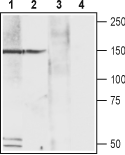Overview
- Peptide (C)SERPQEMGRLLGEADG, corresponding to amino acid residues 881-896 of mouse CaVα2δ4 (Accession Q5RJF7). Extracellular.

Human - not recommended for use with human samples.
 Western blot analysis of rat DRG (lanes 1 and 3) and rat PC12 pheochromocytoma cell lysates (lanes 2 and 4):1,2. Anti-CACNA2D4 (CaVα2δ4) (extracellular) Antibody (#ACC-104), (1:200).
Western blot analysis of rat DRG (lanes 1 and 3) and rat PC12 pheochromocytoma cell lysates (lanes 2 and 4):1,2. Anti-CACNA2D4 (CaVα2δ4) (extracellular) Antibody (#ACC-104), (1:200).
3,4. Anti-CACNA2D4 (CaVα2δ4) (extracellular) Antibody, preincubated with CACNA2D4/Cavα2δ4 (extracellular) Blocking Peptide (#BLP-CC104).
 Expression of CaVα2δ4 in rat C6 cellsCell surface detection of CaVα2δ4 in intact living rat brain glioma (C6) cells. A. Extracellular staining of cells with Anti-CACNA2D4 (CaVα2δ4) (extracellular) Antibody (#ACC-104), (1:50) followed by goat anti-rabbit-AlexaFluor-594 secondary antibody (red). B. Nuclear staining of cells using the cell-permeable dye Hoechst 33342 (blue). C. Merged images of A and B.
Expression of CaVα2δ4 in rat C6 cellsCell surface detection of CaVα2δ4 in intact living rat brain glioma (C6) cells. A. Extracellular staining of cells with Anti-CACNA2D4 (CaVα2δ4) (extracellular) Antibody (#ACC-104), (1:50) followed by goat anti-rabbit-AlexaFluor-594 secondary antibody (red). B. Nuclear staining of cells using the cell-permeable dye Hoechst 33342 (blue). C. Merged images of A and B.
- Catterall, W.A. (2000) Annu. Rev. Cell. Dev. Biol. 16, 521.
- Qin, N. et al. (2002) Mol. Pharmacol. 62, 485.
- De Jongh, K.S. et al. (1990) J. Biol. Chem. 265, 14738.
- Sipos, I. et al. (2000) Pflug. Arch. 439, 691.
- Dolphin, A.C. (2009) Curr. Opin. Neurobiol. 19, 237.
- Cooper C.L. et al. (1987) J. Biol. Chem. 262, 509.
- Wycisk, K.A. et al. (2006) Invest. Ophthalmol. Vis. Sci. 47, 3523.
Voltage-gated Ca2+ (CaV) channels are ubiquitously expressed and function as Ca2+ conducting pores in the plasma membrane1. Based on their electrophysiological and pharmacological properties, Ca2+ channels have traditionally been classified into L, T, N, P, Q, and R types2. L-type calcium channels are heteromultimers composed of four independently encoded proteins, the pore-forming α1 subunit, which triggers Ca2+ flow across the membrane, and the auxiliary subunits α2δ, γ, and β3. The Ca2+ channel α2δ subunit is a heavily glycosylated protein that is encoded by a single gene and post-translationally cleaved to yield α2 and δ subunits linked by a disulfide bond with a single transmembrane segment4.
The α2δ subunit regulates many functional aspects of Ca2+ channels, such as gating, regulating voltage dependent kinetics, and increasing functional channel density on the plasma membrane5. There are four proteins that comprise CaVα2δ: CaVα2δ1, CaVα2δ2, CaVα2δ3 and CaVα2δ46. CaVα2δ4 participates in the regulation of membrane expression of CaV channels. It is predominantly expressed in certain types of endocrine cells. It is also detected in the erythroblasts in the fetal liver, in the cells of the zona reticularis of the adrenal gland and in the basophiles of the pituitary. Defects in CaVα2δ4 are the cause of retinal cone dystrophy 4 (RCD4). RCD4 is characterized by minimal symptoms except for slowly progressive reduction in visual acuity7.
Application key:
Species reactivity key:
Anti-CACNA2D4 (CaVα2δ4) (extracellular) Antibody (#ACC-104) is a highly specific antibody directed against an epitope of the mouse protein. The antibody can be used in western blot, immunocytochemistry and immunohistochemistry applications. It is especially suited to detect CaVα2δ4 in living cells. It has been designed to recognize CaVα2δ4 from rat and mouse samples.
Applications
Citations
- Mouse adrenal gland lysate (1:200).
Toft-Bertelsen, T.L. et al. (2016) Mol. Biol. Cell 27, 3329.

